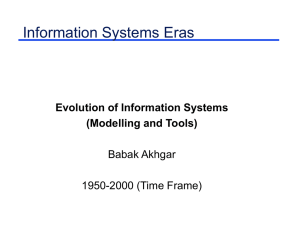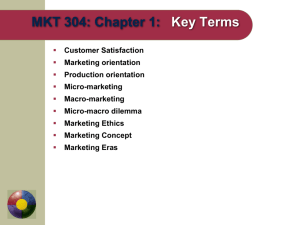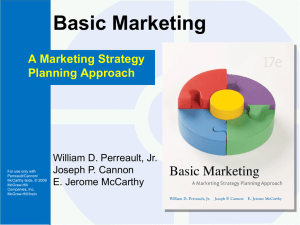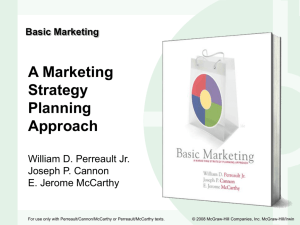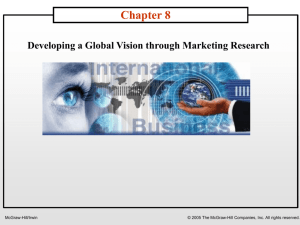marketing concept
advertisement
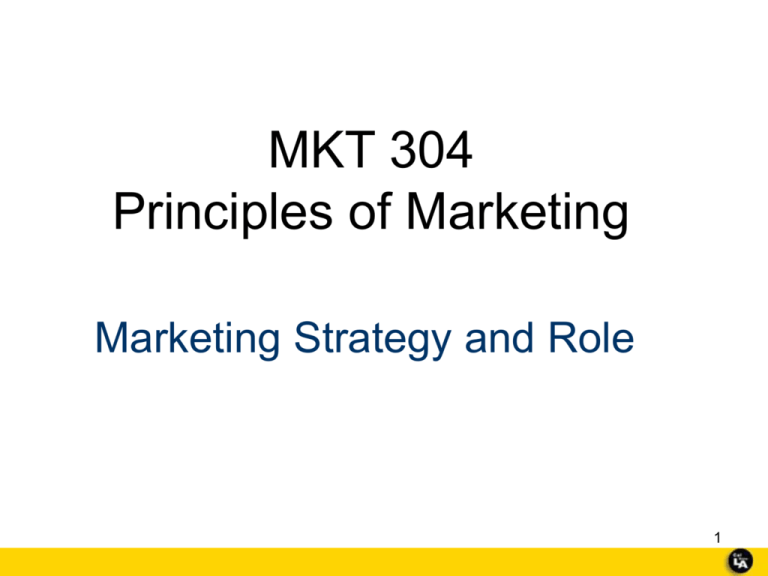
MKT 304 Principles of Marketing Marketing Strategy and Role 1 Announcements • Those who missed last class to pick up course outline and complete first in class exercise by today. • Please register for the discussion forum if you have not done so. Of course, feel free to post comments and ideas. 2 Marketing Evolution • Simple trade era (before Industrial Revolution) – Trade of “surplus” output; – Focus: Sell surplus • Production era (Industrial Revolution to 1920s) – “If we can make it, it will sell”; – Focus: Increase supply • Sales era (1930s to 1950s) – Business success = sell, sell, sell … ; – Focus: Beat Competition • Marketing department era (1950s) – Short-term marketing plan and limited integration; – Focus: Coordinate and Control • Marketing company era (since 1960s) – Implementation of the marketing concept. – Focus: Long run customer satisfaction 3 • The “Marketing Concept” The marketing concept means that an organization as a whole should seek to make a profit by serving the needs of it customers. Total Customer Satisfaction Company Effort The Marketing Concept Profit 4 The Marketing Concept & Customer Value Take Customer’s Point of View Customer May Not Dwell On Value Costs Benefits Where Does Competition Fit? Customer Value Builds Relationships 5 Putting It All Together Superior Customer Value Total Company Effort to Satisfy Customers Customer Acquisition Profitable Relationships with Customers Customer Satisfaction Customer Retention 6 © 2003 McGraw-Hill Companies, Inc., McGraw-Hill/Irwin Marketing Management • • MARKETING MANAGEMENT PROCESS--the process of (1) planning marketing activities, (2) directing the implementation of the plans, and (3) controlling these plans. STRATEGIC (MANAGEMENT) PLANNING—the managerial process of developing and maintaining a match between an organization’s resources and its market opportunities. Adjust Plans as Needed Marketing Planning Set Objectives Evaluate Opportunities Plan Marketing Strategy Dev plans & programs Control Marketing Plan(s) and Program Whole-Company Strategic Management Planning Implement Marketing Plan(s) and Program 7 Marketing Strategy • Target Market – A group of customers to appeal. • Marketing Mix – Product; – Pricing; – Distribution (Place); – Promotion. • Note: customer is not part of the marketing mix! The Marketing Mix C 8 Product Strategy • Are there different types of customers in the market? • What do these different segments want? • Which segment should we target? • How can we “position” our product toward this segment? • How broad of an assortment of products should we offer? • What are the appropriate quality levels? 9 Pricing Strategy • How price sensitive are potential customers? • What are our competitors charging for similar products? • What is the minimum price we need to charge to cover our variable costs of production and some of our fixed costs? • What price level would be consistent with the desired positioning for our products? 10 Distribution (Place) Strategy • What channel should we use to distribute our products? • What intensity should we deploy in the distribution of our products? • How many “middlemen” should there be between us and our final customers? 11 Promotion Strategy • What should we communicate about our products to potential customers? – Eg: Attributes, Image, Technology etc • How should we communicate to our potential customers? – Eg: Personal Selling, Mass Selling, Sales Promotion • What specific media should we use to communicate? – Eg: Sleep Country USA 12 Attribute Promotion 13 Marketing Mix & The Customer Product Price Customer Place Promotion 14 In a Nutshell………… Product Physical Goods Service Features Quality Level Accessories Installation Instructions Warranty Product Lines Packaging Branding Place Objectives Channel Type Market Exposure Kinds of Middleman Kinds and Locations of Stores How to Handle Transporting and Storing Service Levels Recruiting Middlemen Managing Channels Promotion Objectives Blend Salespeople Kind Number Selection Training Motivation Advertising Targets Kinds of Ads Media Type Copy Thrust Who Prepares? Sales Promotion Publicity Price Objectives Flexibility Level over Product Life Cycle Geographic Terms Discounts Allowances 15 Target Marketing Marketing Mix Target Market 16 Mass Marketing 17 The Marketing Plan Guides Implementation and Control Target Market + Marketing Mix = Marketing Strategy + TimeRelated Details = Marketing Plan + Other Marketing Plans = A Firm’s Marketing Program 18 © 2003 McGraw-Hill Companies, Inc., McGraw-Hill/Irwin Creative Strategy Planning Needed for Survival Death-wish marketing Best-practices marketing (Below average) 68% (Average Marketing Program) (Well below average) 2% Failure (Above average) 14% Poor Fair (Well above average) 14% Good 2% Exceptional 19 © 2003 McGraw-Hill Companies, Inc., McGraw-Hill/Irwin A Marketing Success: HarleyDavidson Course Packet Look for the buzz words: customer competition company product price distribution promotion 20 Facts of Harley Marketing • • • • • • • • • • • • • • • • • • • Customers: What are their demographics?Who are they? 38, 53K, 60% married, 30% college, 95% male “Rubbies” seeking individuality and escape from weekday pressures; Competition: From? Japanese firms, British Imports, California Company and Victor Bike; Company: the up-and-downs in history? 1903, great depression, WW2, 1950s,1960s, 1970s AMF, 1980s; Product: What happened to the product? Oil leaks and breakdowns Restructuring? Update equipment, improve production increase employee involvement, reduce cost, fewer employees, cut in exec salaries, ties with suppliers, JIT deliveries Current Harley? Enhance quality, keep up with trends and customer needs, product lines of accessories and apparel, to allow customized looks; Price: What/why that level? high-price, price inelasticity for exclusive image Distribution(place):What was done? carefully manages the number and location of dealers, help dealers design store layout and plan inventory to meet local needs; Promotion: What was done? 21 HOG rallies, Hog Tales magazine, printed ads to promote lifestyle Next Time • Find a group of 5 if you have not got into any one or u can work alone • Read Chapter 4 • Think critically how any businesses around you capitalize on the opportunities that are present. See You Next Time! 22 End Lecture 1a 23


